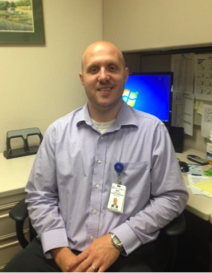
Disease Manager–COPD Readmissions Reduction
Beginning Oct. 1, hospitals will face stiff penalties for excessive readmissions for COPD. Many are now in the process of developing COPD disease management programs aimed at avoiding those costly readmissions. As a key clinician in the care of COPD patients, respiratory therapists have the right mix of skills to take on new roles as disease managers for these patients, and in many places around the country, that’s already happening.
AARC member Eric Hayes, RRT, AE-C, TTS, represents one of this new breed of RT, who are not only working to protect their hospitals against financial loss due to readmissions but more importantly, to improve the quality of life available to their patients with COPD. We asked him to tell us more about his exciting new position —
How long you have been an RT and where are you working now?
I have been a respiratory therapist at West Virginia University Hospital for ten years and a clinical specialist for seven of those ten years.I always knew that I wanted a career in healthcare but wasn’t sure what I wanted to pursue until I discovered respiratory therapy.
How did you end up in your hospital’s COPD readmissions reduction program?
I was working as a clinical specialist when we started to implement our COPD readmission reduction program.Originally, it was divided up between the five clinical specialists within our department.We soon realized that someone needed to take ownership over this endeavor.Because I was so involved with the implementation process, I volunteered to take over the initiative.My responsibilities then shifted to focus solely on reducing our readmission rates.
Did you have to get any special training to take on the disease manager position?
There was no special training required but I did take a certification course to become a Tobacco Treatment Specialist.In West Virginia, we have a large population of patients with COPD and many of them continue to smoke.Taking this course helped prepare me to better answer their questions, help those individuals that are interested in quitting smoking, and make them aware of the resources available to them.The course also improved my motivational interviewing skills.I am also a Certified Asthma Educator,which helps when I am working to develop an effective action plan with each of the COPD patients.
What does the position entail and how do you feel you are making a difference in the lives of your patients?
Each day a report is generated that shows who has been admitted with a COPD exacerbation.From that list, I do a quick chart review to see what medications they were taking prior to admission, prior PFT results if available, etc.I then interview the patient to get a better understanding of their specific challenges at home and evaluate their health literacy.After interviewing and educating the patient a discussion is held with the physician and care management team to address any other potential barriers.
A post-discharge follow up phone call is made after 48-72 hours to ensure the patient doesn’t have any outstanding questions, and to make sure they have the appropriate medications and follow up appointments.Most patients are very appreciative of the fact that we take the extra time to educate them on the medications and proper techniques required with different devices.We have found that it is vitally important to have them return demonstrate everything that we just instructed them on.This ensures that they truly understand and gives them an opportunity to ask more questions.Year to date, we have been able to reduce our COPD all cause readmissions to 12%.
It must be gratifying to work with COPD patients in this new position. What kind of feedback have you gotten from your patients?
Most patients are very surprised when I hand them my business card and tell them that I will be calling them after they are discharged to follow up with them on how things are going.I have built numerous relationships with these patients and made sure that they feel comfortable enough to call me directly with any questions that may arise in the future.It feels great to know that I may have had a small part in making the lives of these patients better.
Do you have an example you can share with us?
One patient in particular was admitted in late December.The patient was able to identify that the extreme cold weather we had been having triggered his exacerbation.He stated that every time he went outside his symptoms would get much worse.This patient had never seen a pulmonologist and was only taking a short-acting beta agonist on an as needed basis.Working with our team it was determined that he could benefit from a long-acting bronchodilator as well as an inhaled corticosteroid.Upon discharge he was scheduled to follow up with a pulmonologist.About a month later this gentleman called and was very excited to tell me that he just shoveled his driveway and did not get short of breath doing it.That alone is verification that our program is a success.
What advice do you have for your fellow therapists who might like to take on the COPD disease manager role in their own facilities?
Having a multidisciplinary team approach is very important.On our team, we have members from care management, pharmacy, quality, and nursing. We meet monthly to discuss any issues that may have arisen and how we can prevent them in the future.
I advise anyone that is interested in this type of position to take as many classes as you can on motivational interviewing and building useful action plans with the patients’ input.You can have the best education material in the world but if you cannot get the patient to buy in and build an effective action plan together it is difficult to make an impact.Having the patient teach back to you is also vital to ensure that they understand.
